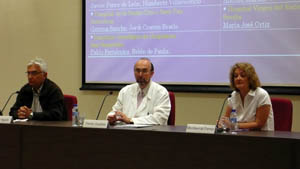
14/05/2008 - Press release
Prostate cancer is the most frequent cancer in men, followed by lung and colon cancers

A study directed by the Catalan Oncology Institute, Bellvitge Hospital and the Municipal Institute of Medical Research indicates that brachytherapy is the treatment that least affects prostate cancer patients’ quality of life.
The study compared the three most common treatments used for localised prostate cancer: excision of the prostate, external beam radiotherapy and brachytherapy with iodine-125 radiation seeds
Treatment with brachytherapy consists of placing a radioactive source, in this case iodine-125, into or near the tumour. The radiation emitted destroys the malignant cells.
Prostate cancer patients treated with this method have a higher quality of life than those treated with external beam radiotherapy or excision of the prostate. The best results obtained by brachytherapy are in regards to sexuality, the area most affected by surgery. External beam radiotherapy, however, is the option that causes the least urinary dysfunction.
These are the conclusions of a study carried out by the Radiotherapy Oncology Department at the Catalan Oncology Institute (ICO), the Department of Urology at Bellvitge Hospital, the Health Services Research Unit at the Municipal Institute of Medical Research (IMIM-Hospital del Mar) and eight other centres in Spain. In the study, published in the International Journal of Radiation Oncology-Biology-Physics, more than 600 patients who underwent three different treatments were surveyed. The treatments were: excision of the prostate (radical prostatectomy), external beam radiotherapy and brachytherapy with iodine-125 radiation seeds.
Prostate cancer
Prostate cancer is the most common tumour in men in Spain, more common than lung cancer and colorectal cancer. 3,500 cases per year are diagnosed in Catalonia, which is 20% of the tumours in the male population.
Currently, more than 70% of diagnosed cases are cured. Of these, more than half are treated with surgery and the rest with radiotherapy (brachytherapy or external beam radiotherapy). Positive results in the treatment of this type of tumour, however, may be accompanied by side effects that impact the patients’ quality of life to some degree. Excision of the prostate and radiotherapy (either external or brachytherapy) may cause alterations in urinary, intestinal and sexual function. The study goes further than the analysis of these side effects and also evaluates the impacts the three treatments have on other aspects, such as the state of physical and mental health, pain and effects on social life.
Quality of life
The study compared the evolution of 275 patients treated with brachytherapy, 205 with external beam radiotherapy and 134 with excision of the prostate.
The results, obtained up to two years after beginning the treatment, indicate that brachytherapy with iodine-125 radiation seeds is the treatment that causes the least problems with impotence and other sexual dysfunctions and is the treatment that least affects patients’ general quality of life. External beam radiotherapy, however, is the option that causes the least incontinence and urinary dysfunction. Finally, according to patient responses, the effect on general quality of life after prostate excision is only during post-operation, though the effects on sexual function continue up to two years after treatment.
Eleven centres throughout Spain participated in this study, among them the ICO and Bellvitge Hospital, which have contributed more than half of the 600 patients included in the sample. A team from IMIM carried out the telephone interviews with the prostate cancer patients that were used to evaluate the impact of the treatments on their quality of life. This survey was done before treatment and after 3, 12 and 24 months. A follow-up is intended for all patients up to 5 years after treatment, which will help to determine whether the results are maintained long-term.
Other centres that contributed patients are: the Oncological Institute of Guipuzcoa, the Capio Hospital General de Catalunya, the oncological institute of Galicia, Ramon y Cajal Hospital in Madrid, Carlos Haya Regional Hospital in Malaga, Virgen del Rocío Hospital in Seville, the Fundació Puigvert in Barcelona and the Hospital de la Santa Creu i Sant Pau in Barcelona.
Servei de Comunicació:
Marta Calsina(ELIMINAR)
Tel:
(+34) 93 316 06 80
Doctor Aiguader, 88
08226 Barcelona
© Institut Hospital del Mar
d'Investigacions MèdiquesLegal Notice and Privacy Policy | Cookie Policy | Site Index | Accessibility | Find Us | Contact